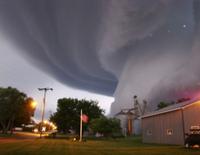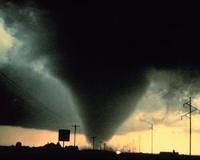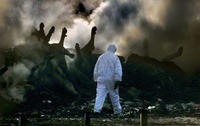-
Emergency medical response in a post-9/11 Washington, D.C.
Beverly Pritchett, the senior deputy director of the Health Emergency Preparedness and Response Administration at the D.C. Department of Health, is a 27-year veteran of the U.S. Army Medical Service Corps; Pritchett discusses improvements made to the city’s emergency medical response capabilities, the integration of smartphones and social media into disaster response plans, and the need for continued funding to sustain the gains made in public health over the past ten years
-
-
Biolabs: the solution may be the problem

Since the fall 2001 anthrax attacks, there has been a vast expansion of the U.S. bioterror research infrastructure; now, more than 11,000 scientists work on bioterrorism and agroterrorism research in seventeen major and many more smaller labs across the United States; billions of federal dollars are funding research on new vaccines and antibiotics to protect the population from anthrax, plague, tularemia, Ebola, and other lethal germs; what is the likelihood that there is another Bruce Ivins — perhaps more than one — among these thousands of researchers with access to the most lethal pathogens on Earth?
-
-
How safe is Kansas bio lab from twisters?

DHS officials say they are confident that the proposed bio-defense lab in Manhattan, Kansas, located in the heart of tornado alley, is capable of withstanding a direct hit from a powerful twister; engineers have hardened the $650 million National Bio and Agro-Defense Facility (NBAF) to withstand wind speeds of up to 230 miles per hour; but critics of the planned facility argue that the new standards are inadequate and that the facility must be further reinforced to ensure that in the event of a natural disaster the deadly pathogens and viruses stored there are not spread
-
-
Kansas House cuts troubled agency's role in funding of bio lab
DHS has chosen Kansas State University (KSU) in Manhattan, Kansas, as the location for the new, $650 million Level 4 BioLab, which will replace the aging lab on Plum Island, New York; the federal laboratory will be the U.S. premier facility for research into countering possible bioterrorism attacks and threats to the nation’s food supply; the Kansas Bioscience Authority (KBA) was supposed to handle the issuing of $105 million in bonds to develop the lab, but the KBA’s chief executive has recently resigned under a cloud, and the agency’s business practices are now being investigated the Johnson County District Attorney; the Kansas House voted to cut the KBA out of handling the bond issue; “We didn’t want any kind of hint of a problem,” said one House member
-
-
Information about Maryland biolabs scarce
High-level containment laboratories and storage facilities that handle dangerous biological agents exist in Frederick County, Maryland, outside the secured gates of Fort Detrick, but state law mandates that the number and location of each remains confidential; supporters of the current system say that confidentiality is critical to maintain the security and safety of the labs, but critics argue that the secrecy makes it impossible for emergency services in the neighborhood to prepare properly for accidents
-
-
Controversy of Kansas biosecurity lab continues

KSU attracted the $650 million National Bio and Agro-Defense Facility for making vaccines and anti-virals to combat the world’s most dangerous animal diseases, beating out the competition during a multi-year screening process; in addition, KSU is planning a 26 April open house for a brand-new “innovation campus” west of Kansas City that will provide graduate level and professional science master’s degree programs (targeted versions of traditional academic programs) as well as industry training in animal health, food safety, and bio-security for more than 120 companies located in the “Kansas City animal health corridor”; critics say that building such a lab in Kansas — one of the largest livestock producing states, and a state which lies at the nation’s transportation crossroads and in the middle of Tornado Alley — is not such a good idea
-
-
Terror attack fears over London virus superlab
Experts express concern over the 600 million Pound virus “superlab” planned for St. Pancras, London; the 14-story, maximum security site containing viruses including malaria, tuberculosis, bird and swine flu, cancer cells, and HIV would need to be “bulletproof” to withstand not only an earthquake, a bomb, or fire — there are also worries that Tube trains running through King’s Cross and Euston stations could ruin delicate and expensive laboratory equipment
-
-
Ohio man indicted on possession of deadly bioagent ricin

Jeff Boyd Levenderis, 54, of Akron, Ohio has been indicted by a federal grand jury for a false statement and for the possession of ricin, a Schedule 1 substance capable of being processed and employed as a biological or chemical weapon according to the Chemical Weapons Convention; Levenderis’ attorney has said that no evidence has been found that his client had ever intended to harm anyone
-
-
U.S. will carefully watch, but not regulate, synthetic biology
White House commission says biologists can engineer custom organisms from synthetic genomes, with the government watching but not regulating the research; critics claim synthetic biology will create unnatural organisms likely to wreak havoc on the larger ecosystem if they got loose in the wild — to say nothing of the risks of bioterrorists using design pathogens; self-regulation, say the critics, is equivalent to no regulation
-
-
Hope for Plum Island in unease about Kansas biolab?
Last month the National Research Council issued a safety report which concluded that there is a 70 percent chance of pathogen release from the proposed Manhattan, Kansas BioLab-4 over a 50-year period; The New York congressional delegation points out that upgrading safety at Plum island will cost far less than the $400 million price tag for the Kansas lab
-
-
More questions raised about security of Boston BioLab
Boston University has opened a $178 million biolab in a residential area in Boston’s South End; the facility, in which lethal diseases such as Ebola and the plague will be studies, houses only administrative staff, pending state approval; that approval depends on a final risk assessment review — but a new study by the National Research Council questioned the methodology of ongoing risk assessment by contractor Tetra Tech
-
-
Report: DHS underestimates risks of accidental pathogen release at Kansas BioLab
Manhattan, Kansas, is the proposed location of a new, $450 million BioLab44 DHS research facility; a National Academy of Sciences panel report says that a risk assessment by DHS of the new facility vastly underestimates the risk of an accidental pathogen release from the lab and the associated costs; the NAS report also said last month’s analysis failed to learn from fifteen major accidental releases of the foot and mouth virus around the world
-
-
Safety of planned Kansas Biosafety-Level 4 lab questioned

A new National Research Council report finds “several major shortcomings” in a DHS assessment of risks associated with operating the proposed National Bio- and Agro-Defense Facility (NBAF) in Manhattan, Kansas; one example: the report says there is nearly a 70 percent chance over the 50-year lifetime of the facility that a release of foot-and-mouth disease could result in an infection outside the laboratory, impacting the economy by estimates of $9 billion to $50 billion; roughly 9.5 percent of the U.S. cattle inventory lies within a 200-mile radius of the facility; another concern of the committee was the lack of an early-release detection and response system, clinical isolation facilities, and world-class infectious disease clinicians experienced in diagnosing and treating laboratory staff or communities exposed to dangerous pathogens that affect people
-
-
India to be home to the 7th CDC global disease detection center
One result of President Obama’s visit to India is the agreement to set up a global disease detection centre in India; the center will be part of the global network of detection facilities supervised by the U.S. Centers for Disease Control and Prevention (CDC); the Indian center — the seventh CDC global facility — will monitor deadly pathogens and viruses, outbreak information, coordinate responses, and support the WHO’s Global Outbreak Alert and Response Network to allow rapid identification, confirmation and response to outbreaks of international importance
-
-
Work begins on the new U.S. premier BioLab
DHS has released $40 million to allow work to begin on the U.S. new National Bio and Agro-Defense Facility, located on the campus of Kansas State University; the lab will replace the aging lab on Plum Island as the premier research center to combat the threat of naturally occurring animal diseases or agroterrorism; the Levl 4 BioLab will conduct research on human and animal disease to which there is yet no known cure
-
- All
- Regional
- Water
- Biometrics
- Borders/Immig
- Business
- Cybersecurity
- Detection
- Disasters
- Government
- Infrastructure
- International
- Public health
- Public Safety
- Communication interoperabillity
- Emergency services
- Emergency medical services
- Fire
- First response
- IEDs
- Law Enforcement
- Law Enforcement Technology
- Military technology
- Nonlethal weapons
- Nuclear weapons
- Personal protection equipment
- Police
- Notification /alert systems
- Situational awareness
- Weapons systems
- Sci-Tech
- Sector Reports
- Surveillance
- Transportation
Advertising & Marketing: advertise@newswirepubs.com
Editorial: editor@newswirepubs.com
General: info@newswirepubs.com
2010-2011 © News Wire Publications, LLC News Wire Publications, LLC
220 Old Country Road | Suite 200 | Mineola | New York | 11501
Permissions and Policies
Editorial: editor@newswirepubs.com
General: info@newswirepubs.com
2010-2011 © News Wire Publications, LLC News Wire Publications, LLC
220 Old Country Road | Suite 200 | Mineola | New York | 11501
Permissions and Policies
